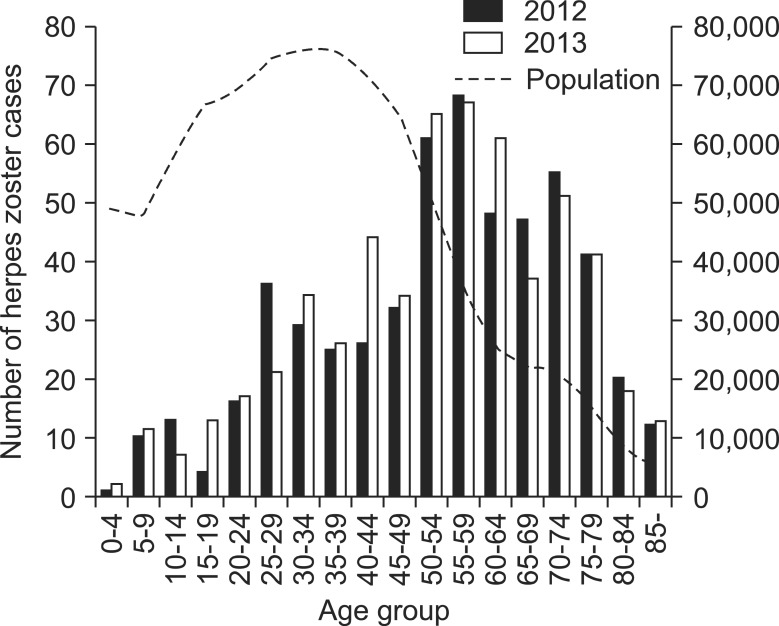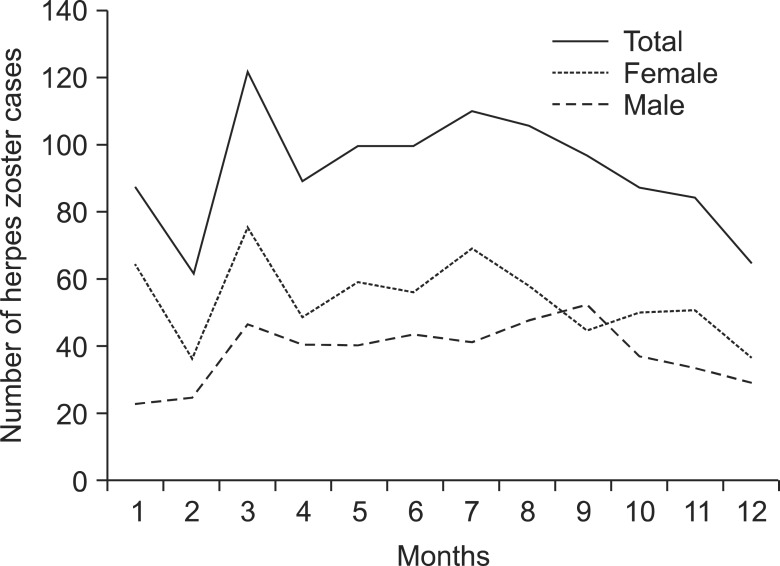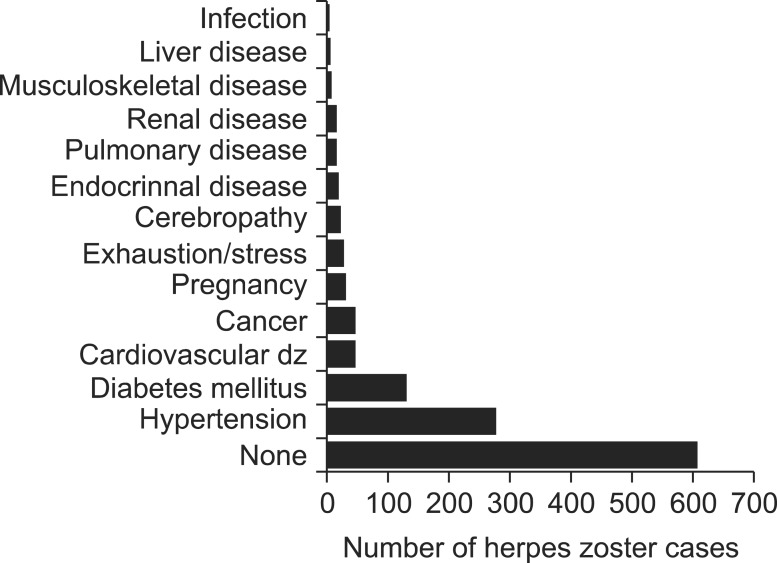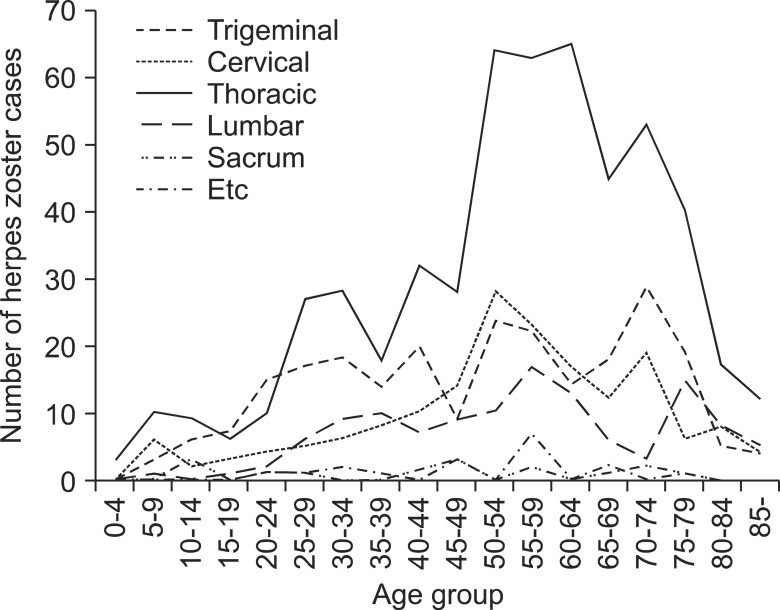Korean J Pain.
2015 Jul;28(3):193-197. 10.3344/kjp.2015.28.3.193.
Epidemiological Study on the Incidence of Herpes Zoster in Nearby Cheonan
- Affiliations
-
- 1Department of Anesthesia and Pain Medicine, Soonchunhyang University Cheonan Hospital, Soonchunhyang University College of Medicine, Cheonan, Korea. doc0126@dreamwiz.com
- KMID: 2149463
- DOI: http://doi.org/10.3344/kjp.2015.28.3.193
Abstract
- BACKGROUND
Herpes Zoster is a disease that occurs after the virus is reactivated due to infection of the varicella virus in childhood. Risk factors are advanced age, malignant neoplasm, organ transplantation, immunosuppressive agents taking are known. The purpose of this study was to investigate the relationship between the seasonal effect and other risk factors on the incidence of herpes zoster.
METHODS
The medical records of 1,105 patients admitted to the outpatient diagnosed with herpes zoster were retrospectively examined. The patients' sex, age, dermatome, onset, underlying disease, residential areas were collected.
RESULTS
The incidence of women outnumbered men and increased for those above the age of 50. The number of occurrences of herpes zoster patients was higher in the spring and summer than in winter. Unlike men, women had the most frequent outbreaks in March. The most common occurrence of dermatome is in the thoracic region. The number of occurrence was similar on the left as the right.
CONCLUSIONS
In this study, herpes zoster occurs more often in women than in men and more frequently occurs in women in the spring and summer.
Keyword
MeSH Terms
Figure
Cited by 1 articles
-
Risk Factor and Prevention of Postherpetic Neuralgia
Jae Hun Kim
Korean J Pain. 2015;28(3):167-168. doi: 10.3344/kjp.2015.28.3.167.
Reference
-
1. Donahue JG, Choo PW, Manson JE, Platt R. The incidence of herpes zoster. Arch Intern Med. 1995; 155:1605–1609. PMID: 7618983.
Article2. Ragozzino MW, Melton LJ 3rd, Kurland LT, Chu CP, Perry HO. Population-based study of herpes zoster and its sequelae. Medicine (Baltimore). 1982; 61:310–316. PMID: 6981045.
Article3. Insinga RP, Itzler RF, Pellissier JM, Saddier P, Nikas AA. The incidence of herpes zoster in a United States administrative database. J Gen Intern Med. 2005; 20:748–753. PMID: 16050886.
Article4. Weitzman D, Shavit O, Stein M, Cohen R, Chodick G, Shalev V. A population based study of the epidemiology of Herpes Zoster and its complications. J Infect. 2013; 67:463–469. PMID: 23872209.
Article5. Dopico XC, Evangelou M, Ferreira RC, Guo H, Pekalski ML, Smyth DJ, et al. Widespread seasonal gene expression reveals annual differences in human immunity and physiology. Nat Commun. 2015; 6:7000. PMID: 25965853.
Article6. Miller E, Marshall R, Vurdien J. Epidemiology, outcome and control of varicella-zoster infection. Rev Med Microbiol. 1993; 4:222–230.
Article7. Toyama N, Shiraki K. Society of the Miyazaki Prefecture Dermatologists. Epidemiology of herpes zoster and its relationship to varicella in Japan: a 10-year survey of 48,388 herpes zoster cases in Miyazaki prefecture. J Med Virol. 2009; 81:2053–2058. PMID: 19856466.
Article8. Wharton M. The epidemiology of varicella-zoster virus infections. Infect Dis Clin North Am. 1996; 10:571–581. PMID: 8856352.
Article9. Shin DY, Koo DW. Statistical analysis of herpes zoster in Chuncheon and the northern Kangwon province (1994-1996). Korean J Dermatol. 1998; 36:422–429.10. Park SY, Kim JY, Kim CD, Kim CW, Lee KS. A clinical study on herpes zoster during the last 10-year-period (1994-2003). Korean J Dermatol. 2004; 42:1531–1535.11. Kim SY, Cho BH, Kim JH. A 5-year clinical study on herpes zoster: 1990-1994. Korean J Dermatol. 1997; 35:266–272.13. Gialloreti LE, Merito M, Pezzotti P, Naldi L, Gatti A, Beillat M, et al. Epidemiology and economic burden of herpes zoster and post-herpetic neuralgia in Italy: a retrospective, population-based study. BMC Infect Dis. 2010; 10:230. PMID: 20682044.
Article14. Thomas SL, Hall AJ. What does epidemiology tell us about risk factors for herpes zoster? Lancet Infect Dis. 2004; 4:26–33. PMID: 14720565.
Article15. Fleming DM, Cross KW, Cobb WA, Chapman RS. Gender difference in the incidence of shingles. Epidemiol Infect. 2004; 132:1–5. PMID: 14979582.
Article16. Law B, Fitzsimon C, Ford-Jones L, McCormick J, Rivière M. Cost of chickenpox in Canada: part II. Cost of complicated cases and total economic impact. The Immunization Monitoring Program-Active (IMPACT). Pediatrics. 1999; 104:7–14. PMID: 10390253.
Article17. Somekh E, Dalal I, Shohat T, Ginsberg GM, Romano O. The burden of uncomplicated cases of chickenpox in Israel. J Infect. 2002; 45:233–236. PMID: 12423610.
Article18. Yu SJ, Lee SM, Chung KD, Youn EK, Yoon KJ. Herpes zoster in healthy child: a case report. Korean J Pain. 2008; 21:71–73.
Article19. Nelson RJ. Seasonal immune function and sickness responses. Trends Immunol. 2004; 25:187–192. PMID: 15039045.
Article20. Zak-Prelich M, Borkowski JL, Alexander F, Norval M. The role of solar ultraviolet irradiation in zoster. Epidemiol Infect. 2002; 129:593–597. PMID: 12558343.
Article
- Full Text Links
- Actions
-
Cited
- CITED
-
- Close
- Share
- Similar articles
-
- A Case of Isolated Iridoplegia in Herpes Zoster Ophthalmicus
- A Clinical Study of Motor Involvement by Herpes Zoster
- A Study of Cellular and Humoral Immunity in Patients with Herpes Zoster
- Epidemiological and Clinical Study on Herpes Zoster in the Province of Chungcheongnam-do (2004~2006)
- Herpes Zoster Treated with Vidarabine-5-Monophosphate






